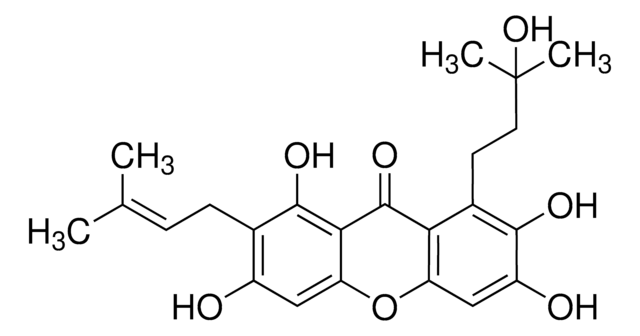382110
Histone Acetyltransferase Inhibitor II
The Histone Acetyltransferase Inhibitor II, also referenced under CAS 932749-62-7, controls the biological activity of Histone Acetyltransferase. This small molecule/inhibitor is primarily used for Cell Structure applications.
别名:
Histone Acetyltransferase Inhibitor II, 2,6- bis-(3-Bromo-4-hydroxybenzylidene)cyclohexanone, HAT Inhibitor II, p300/CBP Inhibitor II, GCN5 Inhibitor I, 2,6-bis-(3-Bromo-4-hydroxybenzylidene)cyclohexanone, HAT Inhibitor II, p300/CBP Inhibitor II, GCN5 Inhibitor I
登录查看公司和协议定价
所有图片(1)
About This Item
推荐产品
品質等級
化驗
≥97% (HPLC)
形狀
solid
製造商/商標名
Calbiochem®
儲存條件
OK to freeze
protect from light
顏色
yellow
溶解度
ethanol: 10 mg/mL
DMSO: 25 mg/mL
運輸包裝
ambient
儲存溫度
2-8°C
InChI
1S/C20H16Br2O3/c21-16-10-12(4-6-18(16)23)8-14-2-1-3-15(20(14)25)9-13-5-7-19(24)17(22)11-13/h4-11,23-24H,1-3H2/b14-8+,15-9+
InChI 密鑰
YOLKEKNTCBWPSD-VOMDNODZSA-N
一般說明
A cell-permeable bis-arylidene cyclohexanone compound that acts as a p300/CBP-selective histone acetyltransferase inhibitor (IC50 = 5 µM), while it affects GCN5 and PCAF only at much higher concentrations (30% and 0% inhibition, respectively, at 5 µM inhibitor concentration). Shown to decrease histone H3 acetylation (IC50 ≤ 40 µM) and induce chromatin condensation in HeLa cells.
A cell-permeable bis-arylidene cyclohexanone compound that acts as a p300/CBP-selective histone acetyltransferase inhibitor (IC50 = 5 µM), while it affects GCN5 and PCAF only at much higher concentrations (30% and 0% inhibition, respectively, at 5 µM inhibitor concentration). Shown to decrease histone H3 acetylation (IC50 ≤40 µM) and induce chromatin condensation in HeLa cells.
包裝
Packaged under inert gas
警告
Toxicity: Standard Handling (A)
重構
Following reconstitution, aliquot and freeze (-20°C). Stock solutions are stable for up to 1 month.
其他說明
Costi, R., et al. 2007. J. Med. Chem.50, 1973.
法律資訊
CALBIOCHEM is a registered trademark of Merck KGaA, Darmstadt, Germany
儲存類別代碼
11 - Combustible Solids
水污染物質分類(WGK)
WGK 1
閃點(°F)
Not applicable
閃點(°C)
Not applicable
Lingling Meng et al.
Heliyon, 10(6), e27045-e27045 (2024-03-19)
Imbalances between Bcl-2 and caspase-3 are significant evidence of apoptosis, which is considered an influential factor in rapidly occurring neuronal cell death and the decline of neurological function after stroke. Studies have shown that acupuncture can reduce poststroke brain cell
我们的科学家团队拥有各种研究领域经验,包括生命科学、材料科学、化学合成、色谱、分析及许多其他领域.
联系技术服务部门








